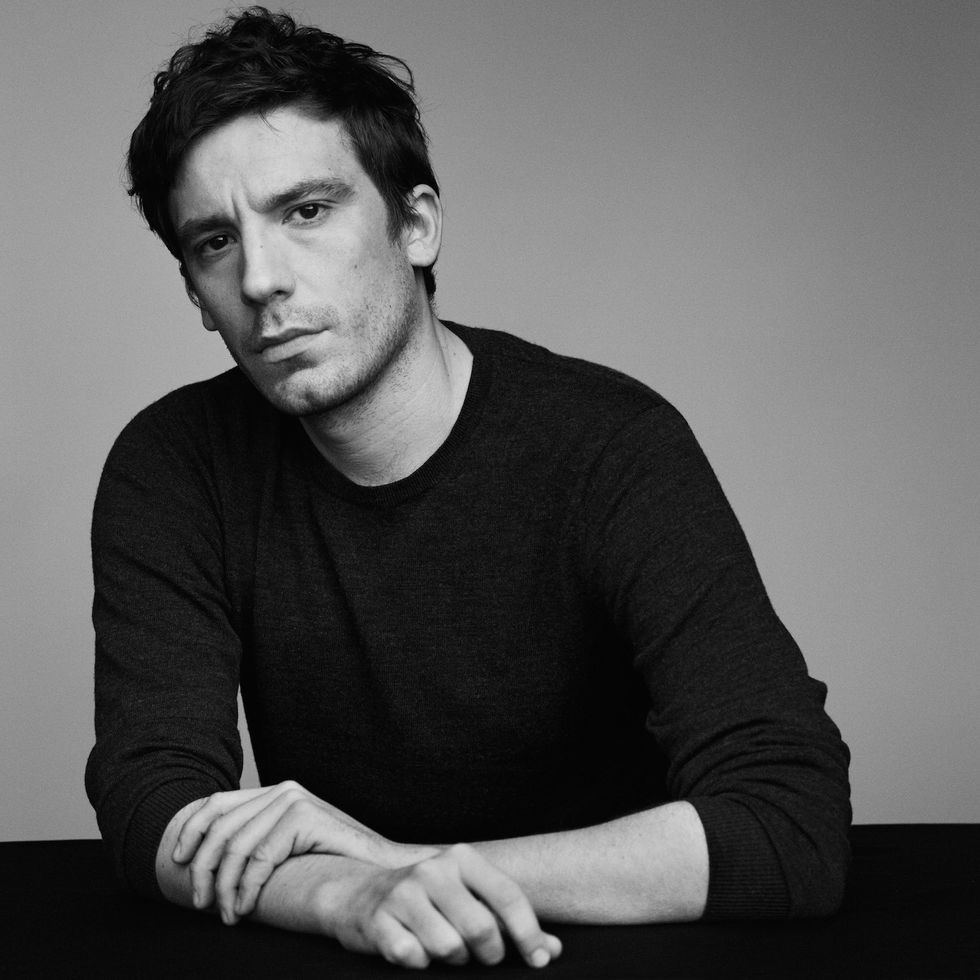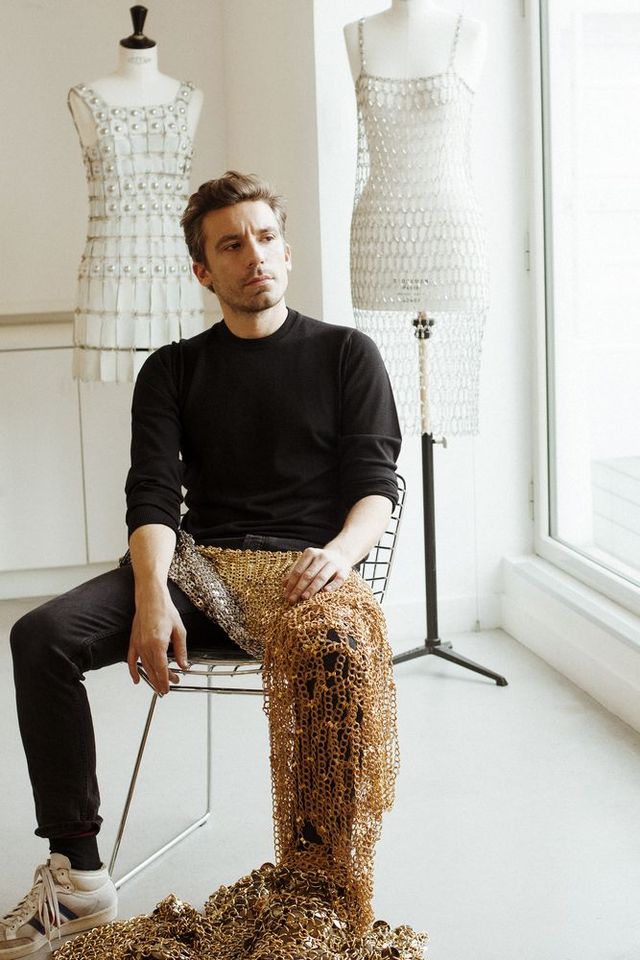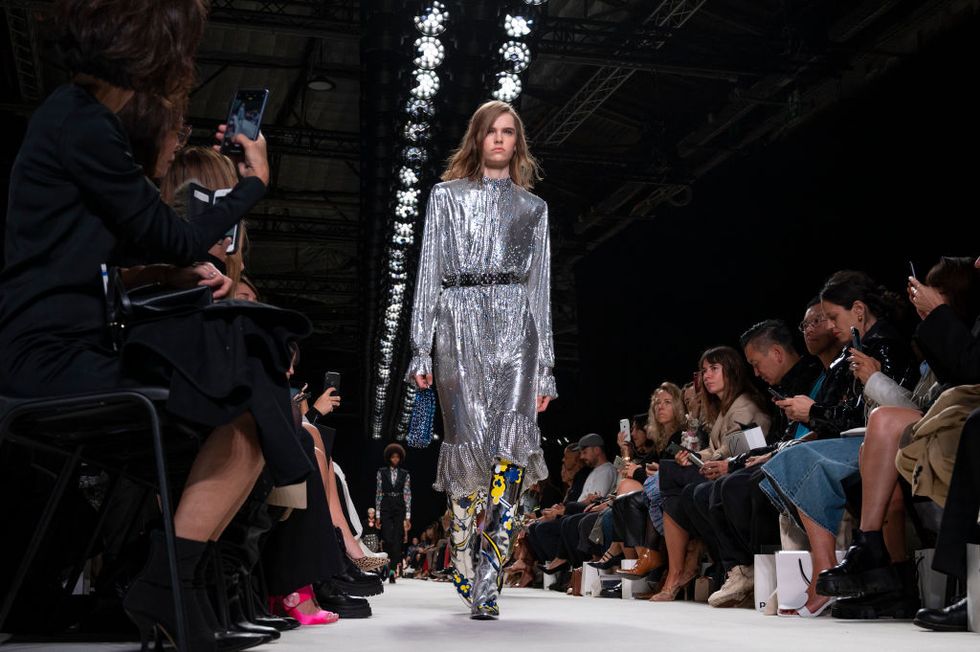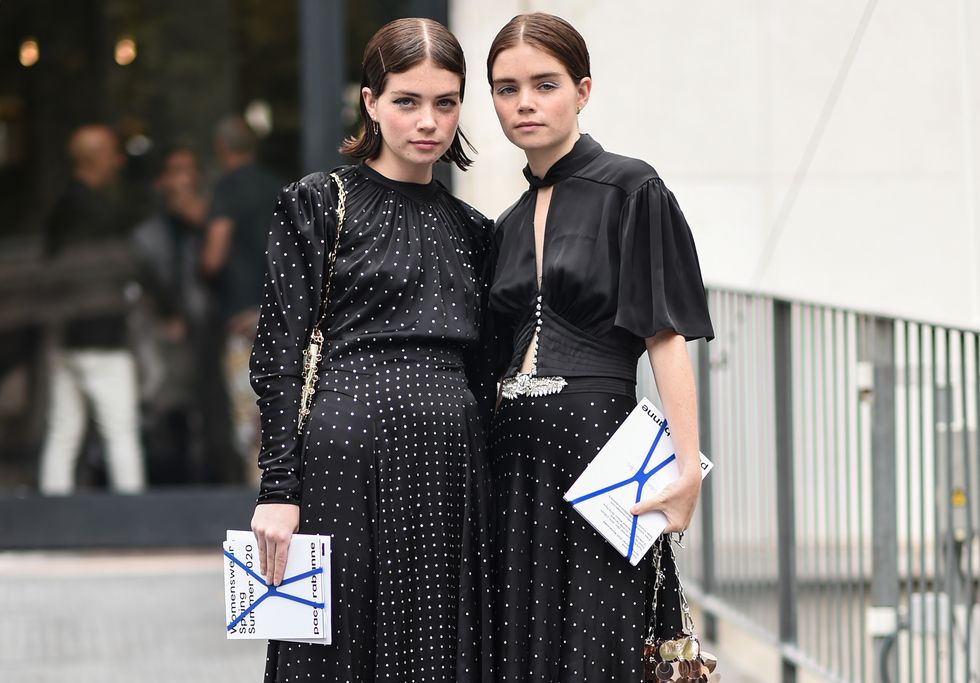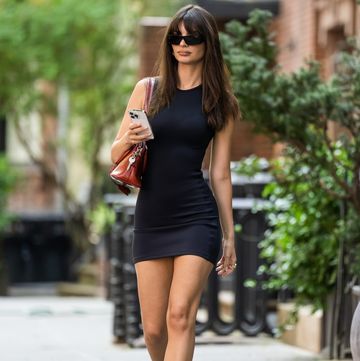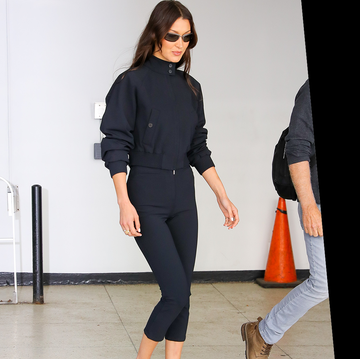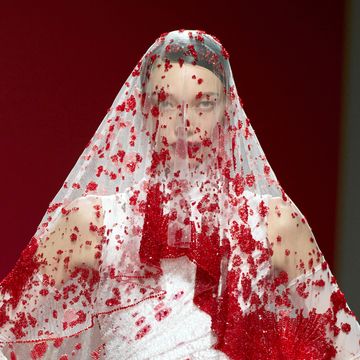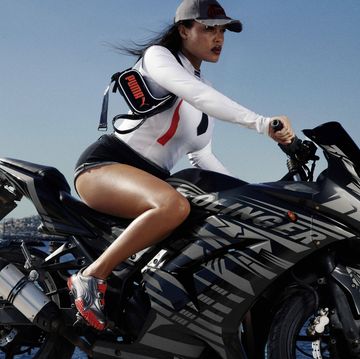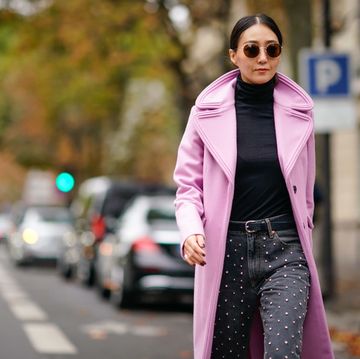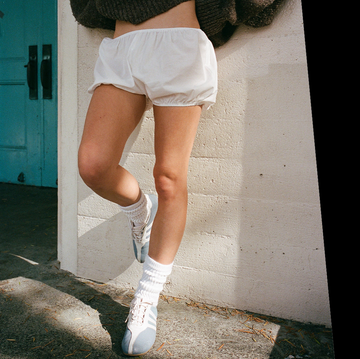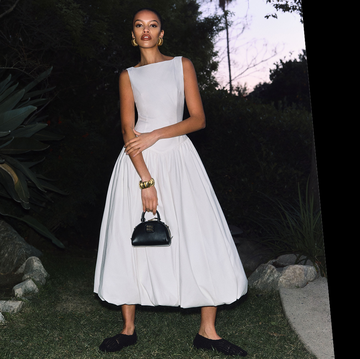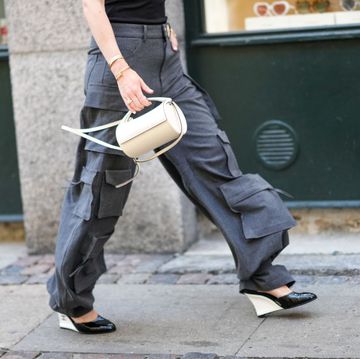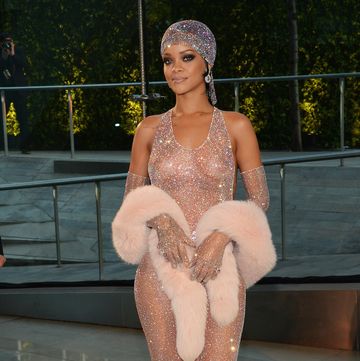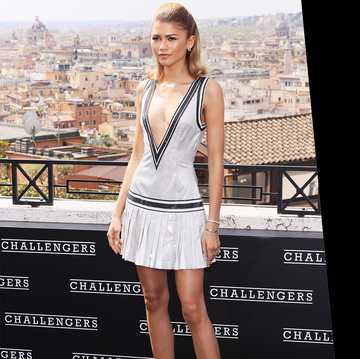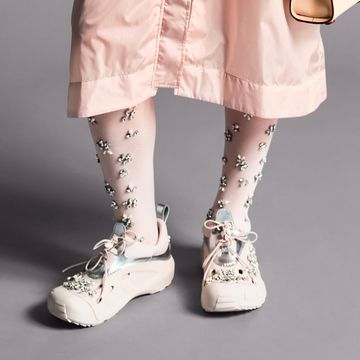Julien Dossena’s brow is furrowed. He looks deep in thought, with one hand half-obscuring his face (one that, it’s worth noting, is conspicuously good-looking — Hollywood handsome, actually, with dark, intense eyes and Robert Redford laugh lines).
Dossena wears the uniform of every preternaturally cool male designer when we meet: low-key in a plain black T-shirt, blue jeans and Adidas trainers. But it’s a studied cool: the T-shirt is immaculate, as if brand new, by Prada; the trainers look box-fresh; and the socks are the kind of white you’d expect to see in a Daz advert. That’s because Dossena is a master at making the complicated appear casual — a skill he masterfully employs at Paco Rabanne, where he has been artistic director since 2013, transforming the fortunes (and reputation) of the 53-year-old fashion house.
Dossena laughs when I suggest he makes it look easy. ‘I am a really doubtful person,’ he admits, before letting his eyes fall to a spot that marks an otherwise-pristine table in Paco Rabanne’s white-walled HQ in Paris. ‘But I’ve always valued hard work. Sometimes stupidly, in the sense that I don’t believe in talent, just hard work. That’s the only reason I’m confident about what I do as a designer. I was surprised, though, when I was hired.’
In fact, a lot of people were surprised when Dossena was named creative director of Paco Rabanne six years ago. He was relatively unknown when he stepped in, and hiring an unfamiliar name over a 'star' designer — a Nicolas Ghesquière, or a Riccardo Tisci — wasn't as common as it is now. Then again, Paco Rabanne, as a ready-to-wear brand, was relatively unknown, certainly to a younger generation more familiar with its affordable perfumes (the sweet, sweet Black XS, and punchy 1 Million).
That wasn’t the case in the 1960s, when Paco Rabanne (real name Francisco Rabaneda Cuervo) rocketed to success with his futurist, space-age styles: chainmail mini-dresses and costumes for 1968 sci-fi film Barbarella. However, half a century later, the brand was considered wacky at best and, at worst, irrelevant as its founder began focusing on art. And prophesying the apocalypse. Its fate as a fashion house seemed sealed when the Basque-born couturier retired in 1999. ‘It was really like… bwoufffff,’ Dossena says, eyes wide and stretching his hands from his temples, as if to suggest it was unfathomably madcap. (The press certainly thought so, nicknaming Rabanne ‘Wacko Paco’.)
Everything has changed under Dossena’s direction, and the brand is once again a fashion house with cool, commercial appeal (albeit following a few false starts with parent group Puig struggling to retain two designers before him: Manish Arora and Lydia Maurer, both lasting a year). Dossena proved the right person to reimagine the brand’s forward-thinking past, making it appeal to a new generation of customers. And he was only 30 when he stepped in. Yet he already had a proven track record as senior designer at a multimillion-pound fashion house.
Dossena was previously a star behind-the-scenes at Balenciaga, working alongside Natacha Ramsay-Levi as the right-hand to then-creative director Nicolas Ghesquière. There, they drove French fashion forward with easy-to-wear separates in futuristic fabrics that stood out against the classic Parisian behemoths: Chanel, Dior and Saint Laurent. ‘The Paris scene was a bit boring before Nicolas,’ Dossena remembers, but he hastily waves his hands to reiterate that he’s not being dismissive of the French monoliths (he has a habit of correcting, or qualifying his statements with appeasing gestures, and a broad, people-pleasing smile). 'It was just that there were no young brands, so I was obsessed with Balenciaga,’ as many young designers eschewing the classicism of traditional French houses were.
Ghesquière and Ramsay-Levi were swiftly rewarded for making Balenciaga one of the most exciting, covetably cool labels of the 21st century, with Ghesquière landing the top job at Louis Vuitton, overseeing womenswear, and Ramsay-Levi now the creative director at Chloé. Dossena’s reward? The recognition that has come from totally transforming Paco Rabanne’s ready-to-wear business.
In the six years Dossena has been at the house, he’s stripped it of the kitschy futurism for which it was once known, typifying space age style with its chainmail and silver paillette handbags. (‘Like in The Jetsons,’ he jokes, before laughing at the memory of the intentionally phallic, metal-shaft dresses in the 1966 film Who Are You, Polly Maggoo?, intended to be parody of Rabanne's work). ‘It was weird, radical, intellectual. A bit crazy.’ he says, clearly excited by the brand's history.
Paco Rabanne now operates with a covert radicalism, under Dossena’s watch, lying in the way pieces are cut, sitting with ease on the body — ‘super precise, like for an attitude,’ he smiles, feigning the act of casually slipping his hands into his pockets. His skill is just that: making the elaborately crafted appear easy and, importantly, cool. From gym wear and tailoring to slinky slips, baroque base layers and vacuum-pack-tight takes on classic pointelle knits, the clothes he designs are simple to wear and simple to style (despite one crystal dress from the AW19 collection taking 144 hours to make). That skill is something he credits to his time at Balenciaga, which he references fondly as we speak. ‘I would still be there if Nicolas was,’ he admits, unprompted. But Ghesquière acrimoniously broke away from the brand in 2012, embroiled in a $9.2 million lawsuit. So that wasn’t an option.
‘I learnt a lot from that, witnessing what can happen when it ends,’ Dossena ruminates, sitting quietly with that thought. You'd expect he's alluding to the challenges of Ghesquière's lawsuit, and the churn-rate of creative directors, often stepping away from big brands in three-year cycles. But, hey, Dossena – despite the studied cool, and the self-doubt – appears as an optimist, again offering that people-pleasing smile in a bid to spotlight the upside.
He recalls how his time at Balenciaga equipped him to steer Atto – his own short-lived label committed to sharp suiting, launched in 2013 – and then Paco Rabanne. ‘I was known as “the pants guy”,’ he laughs. To put being ‘the pants guy’ into context, Balenciaga, back then, was the progenitor of ‘It’ trousers. The past decade’s cargo pants revival? Thank Balenciaga for that. The casualisation of precision-cut slimline tailoring? That too. This all happened in just four years, with Dossena spotted as a uniquely talented intern when he joined the brand in 2008, rapidly rising to become senior designer.
‘Julien was one of the youngest in the studio,’ Ghesquière remembers now, still championing Dossena and cheering from the sidelines — well, from the front row — of every Paco Rabanne show. ‘You could tell it was a vocation, that his future was going to be as the creative director of a house. He had a focus and a work ethic that was beyond his years.’
Ghesquière, Ramsay-Levi, and Dossena photographed for ELLE France.
That work ethic has seen Dossena drive monumental growth at Paco Rabanne, narrowing the revenue gap between its ready-to-wear and multi-million-pound fragrance business. Stockists have doubled in the past year; profits have seen double-digit growth in the past three. And it’s developed a steady following of high-profile fans, from singers Kelela and Rihanna, to well-heeled stars like Priyanka Chopra and Rosie Huntington-Whiteley, proving the versatility of Dossena’s work. It might still be the brand for affordable gifts and sweet starter scents for teens, but it’s now also a go-to for printed wrap skirts, Instagrammable metal-plate bags and logo T-shirts (its purple tie-dye T-shirt with the slogan ‘Lose Yourself’ was one of the shirts of the summer).
To understand Dossena’s early aspirations is to understand what makes him successful now. Growing up in Le Pouldu, a rocky beach town in Brittany, Dossena found art before he found fashion. ‘I figured that I could be a curator. I was excited by art, and thought it was really interesting to be able to connect and create new perspectives,’ he remembers, explaining his decision to study art history at École Supérieure des Arts Appliqués Duperré in Paris, before studying for a Masters in fashion at Le Cambres in Brussels. In fact, whenever the conversation lands on art, Dossena grows increasingly animated. It takes him seconds to work up the energy of a shaken drinks can, driving the conversation with emphatic nods, big gestures and loud ‘Yes!’s.
While Dossena has an artist’s sensibility, the commercial pressure is certainly on: Puig has set the ambitious target for Paco Rabanne to reach €1 billion in revenue by 2020 (to put that into perspective, Balenciaga only recently achieved this, and Saint Laurent is worth €1.7 billion).
‘He really looks very confident, very relaxed, very cool,’ explains former colleague and friend Natacha Ramsay-Levi (herself a Paco Rabanne customer). And he does. That being said, no one is immune to pressure. ‘I’ve developed something that I need to figure out. I’m anxious; I can’t take planes anymore,’ he says. The upside, as there always is, is that Dossena's circuitous, alternative routes have inspired a series of transportive collections. ‘I went to New York by boat, which was really cool,’ he says, feeding into a Paris via Palm Springs Resort collection, photographed against a sunset backdrop. (There were hints of Ziggy Stardust, and Roxy Music, too — a sample of his eclectic taste, which spans 1970's David Bowie, Cher, and the classical piano of Glenn Gould, which even Dossena admits is a bit niche.)
I ask if he is happy, despite the commercial pressures (a result of his own unprecedented success) and newly acquired anxiety. And he flashes that Hollywood smile. ‘Oh yes,’ he says, nodding emphatically. ‘Yes. You’ll see,' hinting that next season will be joyful. 'Colourful and joyful.’ Which it was, appearing on the catwalk just four weeks after we meet: one of the most anticipated – and applauded – shows of Paris Fashion Week.
